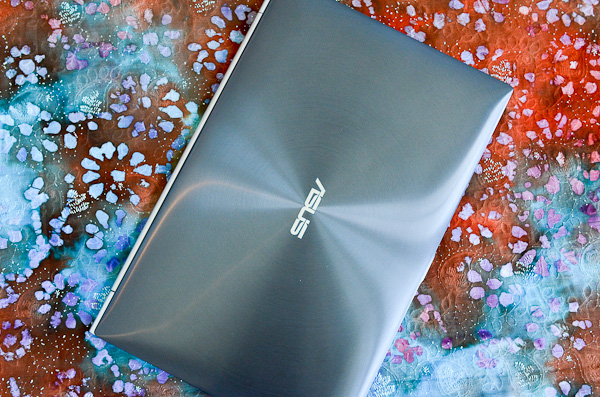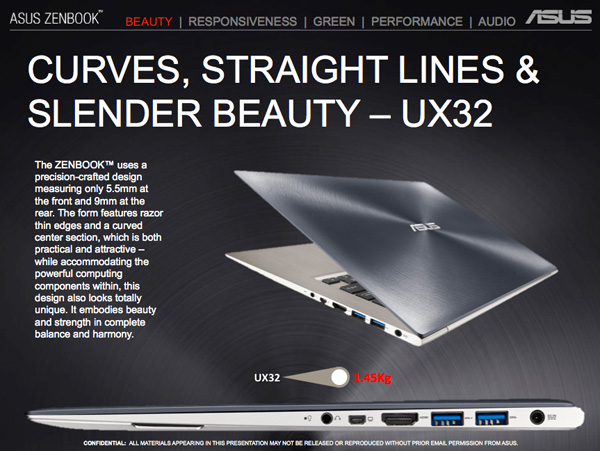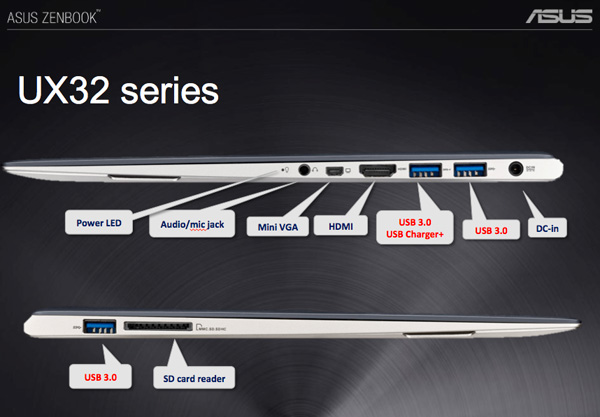ASUS Zenbook Prime (UX21A) Review: The First of the 2nd Gen Ultrabooks
by Anand Lal Shimpi on May 22, 2012 2:46 PM EST- Posted in
- Laptops
- CPUs
- Asus
- Ivy Bridge
- Zenbook
- Zenbook Prime
- Ultrabook
- Notebooks
The first round of Ultrabooks were mostly underwhelming. It shouldn't be a surprise, but many of the efforts were just half hearted at best. Of the companies who shipped the first Ultrabooks however, it was ASUS who came the closest to perfection with the Zenbook.
ASUS' Zenbook embodied the form factor, portability and overall concept of an Ultrabook. Where it failed to deliver was with its keyboard, display and, at least initially, with its trackpad. The first Zenbook was an amazing effort given the short period of time that it was conceived and developed in, but it was too rough around the edges.
Despite only being introduced 7 months ago, the Zenbook is old news. This is the Zenbook Prime:
The Zenbook Prime is ASUS' second generation Ultrabook, built around Ivy Bridge silicon. Unlike most silicon updates to notebooks however, the Zenbook Prime takes an almost Apple-like approach to renovating the tangibles rather than just relying on a faster chip to do the heavy lifting.
I don't know that I've ever seen a faster turn around on implementing reviewer and user feedback into a product. The Zenbook Prime fixes nearly every issue I had with the original Zenbook. From keyboard to display, it's all significantly better with the Zenbook Prime.
The circumstances around today's launch are a bit peculiar. Intel has an embargo in place on the as of yet unreleased Ivy Bridge CPUs, this applies to both notebooks and desktops. One such line of CPUs, the dual-core ultra-low-voltage Ivy Bridge parts that will find their way into many Ultrabooks, is covered by the aforementioned embargo. That embargo lifts at some point in the not too distant future, but ASUS wanted to have its review-ready hardware out the door and getting coverage before then. Why the urgency? It could have something to do with Apple's expected launch of updated MacBook Air and MacBook Pro systems. Rather than for Apple to get all the glory for being first, ASUS set some guidelines: we're allowed to talk about everything to do with the new Zenbook Primes, we just can't get into specifics on the CPU just yet. That's right, you won't read any model numbers, clock speeds or cache sizes here. Given what's already public about the ULV Ivy Bridge lineup I suspect this information isn't too hard to figure out if you're really motivated.

Zenbook Prime (left) vs. Zenbook (right)
The rest of the Zenbook Prime has nothing to do with Ivy Bridge. The form factor of the Zenbook Prime remains unchanged from its predecessor. Just like before we'll see two distinct models, an 11-inch (UX21) and 13-inch (UX31) in for review. With the lid closed, these two look identical to their Prime-less (composite numbered?) counterparts. ASUS sent the 11-inch Zenbook Prime in for review:
| ASUS Zenbook Prime Specs | |||||||||
| UX21A-DB5x | UX21A-DB7x | UX31A-DB51 | UX31A-DB52 | UX31A-DB71 | UX31A-DB72 | ||||
| CPU | ULV IVB | ULV IVB | ULV IVB | ULV IVB | ULV IVB | ULV IVB | |||
| GPU | HD 4000 | ||||||||
| Display | 11.6-inch 1920 x 1080 IPS | 13.3-inch 1920 x 1080 IPS | |||||||
| Memory | 4GB DDR3-1600 (on-board) | ||||||||
| Storage | 128GB U100 SSD | 128/256GB U100 SSD | 128GB U100 SSD | 256GB U100 SSD | |||||
| Wireless Connectivity | Intel Centrino N 6205, 802.11b/g/n 2.4/5GHz 2x2:2, Bluetooth 4.0 | ||||||||
| Battery | 35Wh | 50Wh | |||||||
| Camera | 720p front facing | ||||||||
| Audio | Bang and Olufsen ICEpower | ||||||||
| I/O | 2 x USB 3, 1x audio/mic, 1x microHDMI, 1x miniVGA | 2 x USB 3, 1 x audio/mic, 1 x microHDMI, 1 x miniVGA, 1 x SD Card reader | |||||||
| Dimensions | 299mm x 168.5mm x 3-9mm | 325mm x 223mm x 3-9mm | |||||||
| Weight | 1.1kg | 1.3kg | |||||||
| Price USD | TBD | TBD | $1099 | $1199 | $1499 | $1599 | |||
Pricing is still in the air as the Zenbook Prime won't be shipping until early June. I suspect much of how aggressive ASUS is on this front will depend on what Apple does in the coming weeks.
Introducing the UX32, Starting at $799
There's also a new member of the Zenbook Prime lineup, the 13-inch UX32. Featuring a thicker chassis, the UX32 will be offered as low as $799 with a 1366 x 768 TN panel, hard drive + SSD cache and as high as $1299 with a discrete NVIDIA GeForce GT 620M GPU:
| ASUS Zenbook Prime UX32 Specs | |||||||||
| UX32A-DB31 | UX32A-DB51 | UX32VD-DB71 | |||||||
| CPU | ULV IVB | ULV IVB | ULV IVB | ||||||
| GPU | HD 4000 | NVIDIA 620M + HD 4000 | |||||||
| Display | 13.3-inch 1366 x 768 TN | 13.3-inch 1920 x 1080 IPS | |||||||
| Memory | 2GB DDR3-1600 (on-board) + 2GB or 4GB SO-DIMM | ||||||||
| Storage | 7mm 320GB HDD + 24GB SSD (cache) | 7mm 500GB HDD + 24GB SSD (cache) | 7mm 500GB HDD + 24GB SSD (cache) | ||||||
| Wireless Connectivity | Intel Centrino N 6205, 802.11b/g/n 2.4/5GHz 2x2:2, Bluetooth 4.0 | ||||||||
| Battery | 48Wh | ||||||||
| Camera | 720p front facing | ||||||||
| Audio | Bang and Olufsen ICEpower | ||||||||
| I/O | 3 x USB 3, 1 x audio/mic, 1 x HDMI, 1 x miniVGA, 1 x SD card reader | ||||||||
| Dimensions | 325mm x 223mm x 5.5 - ~9mm | ||||||||
| Weight | 1.44kg | ||||||||
| Price USD | $799 | $999 | $1299 | ||||||
Depending on how well the SSD cache works, and how good the 1366 x 768 panel is, the $799 UX32A could be a very compelling system.













192 Comments
View All Comments
duploxxx - Wednesday, May 23, 2012 - link
quite a bold statement I would say without any proof on Haswell....At a high level, for any modern game, you shouldn't count on being able to run it at the Prime's native 1080p resolution. You need a discrete GPU (or Haswell) to pull that off.
Portal and total war really show what kind of GPU perf you can expect from the HD4000 still too low to run gaming decent just like the diablo3, wouldn't be my favorite "playable" fps
prdola0 - Wednesday, May 23, 2012 - link
I wish Asus added a Kepler-gen GeForce also into the 11" version. Then I'd buy it, but not like this.QQuxa - Wednesday, May 23, 2012 - link
less than 4 hours of internet browsing? :(icrf - Wednesday, May 23, 2012 - link
The UX31A-DB51 will be the perfect replacement for my dad, who's been using a netbook (Asus EEE PC 1000HA) as his primary computer for the last several years. The SSD speed doesn't concern me, but the DPI scaling does a bit, as small text is getting harder to read for his generation.aliasfox - Wednesday, May 23, 2012 - link
Nice machine. I recommended a UX31 to my dad a few weeks ago (needed something by end of May), with the caveat that if he was able to spend more money (business account), that getting the MBA had its advantages - better keyboard and screen, namely. It looks like the new generation does better on the screen and more or less matches the MBA on keyboard (I know Apple wasn't the first with chicklets, but the MBA and UX21A keyboards are so similar that I wouldn't be surprised if they were using the same OEM for the keyboard).My question though is why did ASUS wait until IVB to come out with the chassis (keyboard, screen) changes? If they had been ready near the beginning of the year (just an assumption), ASUS could have definitively trounced the competition, MBA included. Having a paper launch mere weeks ahead of the (expected) new MBA launch - and having a retail launch likely within the same week - gives everybody a lot of incentive to wait and see what the other guy is doing.
I haven't seen mini VGA since my PowerBook G4 from 2003. Wonder if I could sell my decade-old s-video and VGA adapters now!
But yes, TB would've been a much better option than multiple mini video ports...
KPOM - Wednesday, May 23, 2012 - link
It will be nice to see what Apple has in store for the next MacBook Air. The available 1920x1080 display in the 11.6" UX21 is a nice option. Hopefully Apple will see that and raise with a Retina Display (2732x1536), complete with Mountain Lion's new HiDPI.I wonder if Apple will wait for Mountain Lion to be ready before shipping the new Air and Pro (like they did last year with the Air), or if the flood of Ivy Bridge Ultrabooks will force their hand. Mac sales have been a little below estimates the last two quarters, so my guess is that they won't wait for the OS this time around.
hechacker1 - Thursday, May 24, 2012 - link
Pretty sure that Mountain Lion is right around the corner, other than HiDPI stuff, it isn't a huge change from Lion.And they'll absolutely need resolution doubling in place for it to be usable.
I too await to see their competition. Though the prime is already looking good.
ReverendDC - Wednesday, May 23, 2012 - link
This is....nice. I do see incremental improvements in the Ivy Bridge system vs Sandy Bridge. In the end, though it was ASUS that really made this system shine. A 1920x1080 in an 11"?! Whoa!Let's not gloss over the fact that ASUS heard their users' complaints and made the appropriate changes within 6 months. That is extremely rare for a modern PC company, whether MSFT or Apple-based. They really need to receive appropriate kudos for their recent operations. They have definitely become an option for me going forward just for that fact.
What we really need is competent competition. Hopefully, AMD delivers Trinity in a similar form factor for far cheaper than these options. Even the $799 system listed would go for about $499 - $599 with AMD silicon, but you won't get the raw computing power. At the same time, you would have a road warrior gaming system with "good enough" computing. I know this is a bucket I find myself in many times.
Still, nothing to shake a leg at, and great review, AnandTech. Things are improving on the Windows front in terms of design and use.
Sunburn74 - Wednesday, May 23, 2012 - link
There is a limit to how crappy a processor you can have in your laptop and get away with it, even with a SSD. My gf has my asus ul30vt whilst I am using an HP envy 14 (2010). Both have 120gb sandforce SSDs in them. The asus is noticeably more sluggish with everything. Virus scans take over an hour (on my hp envy its about 10 mins), pdfs are choppy, programs take time to load, etc.You can only lowball the processor so much.
Personally, if you're buying a laptop for use for 2-3 years, I'd pay the 200 dollar difference for the more serviceable processor over the long run. When talking about PCs, people talk about future proofing, and not necessarily lowballing your components. You'd think with the less tweakable laptops that concept would be even more prevalent.
IntelUser2000 - Friday, May 25, 2012 - link
It's unlikely you'll see $200 in savings just over the CPU since the top Core i7 is at $300. It would be possible over the Core i7, but its at $999. So you are looking at average of $50 savings for $749, or at most $100 at $699. Going lower AMD would be giving CPUs for free, or sacrificing other components.